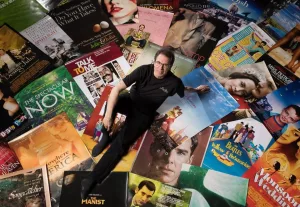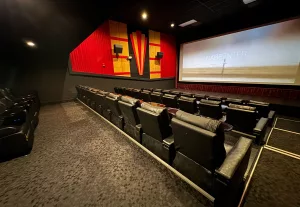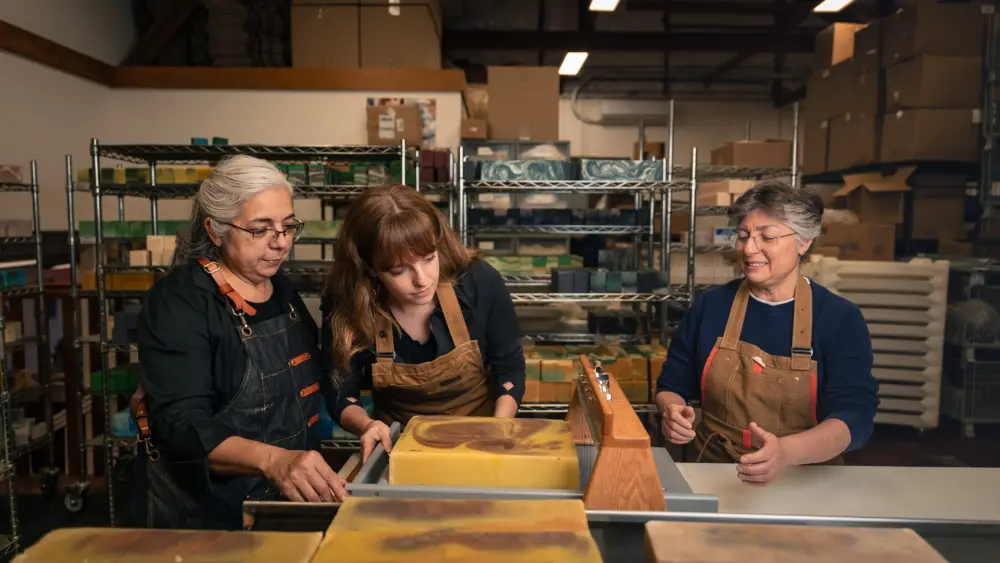
The industry released more PG-rated than PG-13-rated films this year.
When was the last time you left your home to watch a movie in a theater? If the recent uptick in blockbuster films and the flashy technological upgrades are any indication, your visit to a local theater was fairly recent. The trade organization Cinema United (formerly the National Association of Theatre Owners, or NATO) says that about 76% of Americans ages 12 to 74––or approximately 200 million people––went to a movie theater at least once in 2024.
“Ours is truly a Main Street industry with movie theaters anchoring communities of all sizes across this great nation,” says Cinema United president and CEO Michael O’Leary. “Nowhere is this sense of community more evident than in venues run by local enterprising entrepreneurs who bring their artistry, vision and passion for movies, good food, wine and camaraderie to their cinemas each day.”
One of those enterprising entrepreneurs is Ky Boyd, director of Rialto Cinemas, which operates theaters in Sebastopol, Berkeley and El Cerrito. Together, Rialto accounts for 14 “screens” in the Bay Area.

“I do this out of a lot of passion and love and dedication to the art of cinema,” he says. “I’m certainly not getting rich. So we have to be somewhat religious about our message: If you value theaters and what we do, you need to come out to the movies. The sad thing is, we’ve lost more than 30 screens in Sonoma County since the pandemic.” [In March, Summerfield Cinemas in Santa Rosa became the latest closure casualty.]
Nationwide, the total number of screens in operation has decreased to just under 40,000 since 2019, with about 3,000 going dark permanently. After the ravages to the industry from the COVID-19 lockdowns and the subsequent boom in streaming services, it’s taken a toll.
“You can buy a really big television and a kick-ass sound system,” says Boyd, “but you can’t replicate in the home environment the experience of sharing a movie with others in a darkened room. It can be emotional, and it’s kind of magical. In a communal setting, comedies are funnier, horror films are scarier and dramas are just better.”
Filling seats
The push for people to return to theaters seems to be working. Boyd says attendance in 2024 at his theaters was up 17% over 2023, and so far in 2025 attendance is up 16.6% over the same time last year.
“Attendance is the driver,” he says. “It’s all about getting people through the front doors. When we reopened in 2021 after the pandemic, it was bleak, and 2022 was also bleak. After movie production was suspended worldwide during the pandemic, in 2023 we then had the one-two punch of the actors and writers strikes. There were valid and necessary reasons for them to go on strike, but movie production shut down again.”
Yet the last couple of years for Boyd’s company have been encouraging. “Our admissions revenue, just one of our income sources, was up over 20% in 2024. While we sold less than a million dollars in tickets in 2023, we crossed the million-dollar threshold in 2024. Everything in this business is driven by ticket sales, but we also hope customers buy concessions. And there are some harsh realities of the theater concession business. With chick flicks you sell more wine, with action movies you sell more beer, and with documentaries you sell less of everything.”
Rialto’s revenue stream is dependent on the mix of movies it shows, and it has a new product every week on Fridays. “We don’t make the movies, so we are dependent on the distributors, big and small, to give us a diverse selection. What we’ve found is that your most likely future ticket buyer is a person already sitting in your auditorium. We show them up to 10 minutes of previews before a show starts, and hopefully there are some trailers in that 10 minutes that will make them want to see those upcoming films.”
Boyd’s company, he adds, is “financially conservative and risk-averse. We are a capital-intensive, low-margin business.”
Focus on technology
The CEO of Cinema West, Dave Corkill, says his theaters are experiencing higher attendance in the North Bay because of other local theaters closing. In addition to Summerfield, two San Rafael theaters—Cinemark’s Century Northgate and Century Regency—have also closed since the pandemic. “Those closings have boosted our attendance figures. We can’t really attribute the increases to the film product itself. There are just fewer venues now in the North Bay.”

Cinema West operates 15 movie theaters in California and three in Idaho, for a total of 188 screens. In the North Bay, the company runs Boulevard Cinemas in Petaluma, Fairfax Theatre in Fairfax and Larkspur Landing Cinema in Larkspur. Overall, Corkill says, his company has seen an increase of about 15% over where it was last year at the same time.
“We believe that’s because of a better flow of movies,” Corkill says. “We had a really fantastic end to last year, it was very encouraging, and it looks to me like we’ll have a very strong spring and going into fall.”
Corkill says Cinema West lost a lot of revenue over each of the past four years that it would have typically spent on new technology. “This is a tech-intensive business and we have to continually upgrade our projection and sound systems, the seating and so forth. We have to keep the business fresh and at the forefront of our guests’ minds. We’ve done less upgrading than we’d like to, so we anticipate heavy expenditures in upgrading over the next few years.”
He says several new IMAX screens are being installed in some of the company’s theaters, along with a new technology called ScreenX, which has been implemented in three of its theaters already. ScreenX is an immersive experience that expands the action beyond the main screen and onto the theater walls, providing a 270-degree panoramic experience. “We’re also adding motion seats––we see that as an ongoing feature that our industry and our company need to move forward with.”
Cinema West, Corkill explains, is in a slow-growth pattern—but it is in a growth mode. “As with any business, it’s important to look for growth opportunities. This business has changed to the point that we have to stay one step ahead of home entertainment, and that means the theaters we operate need to produce the cash flow to make that happen.”
Robust release calendar
In 2025 so far, the movie theater industry is up 21% overall ahead of last year, according to Comscore, a global media company that measures, among other things, box office performance worldwide. “The big new movie releases this year start in April and May,” says Paul Dergarabedian, a senior media analyst for the company. “The release calendar [for theatrical movies] had fallen off some last year, but it’s coming back much more robust for 2025. We might surpass the $9 billion in revenues we saw in 2024, and 2026 looks even stronger.”

Business was very good in theaters last fall, he says, “We were hearing that venues were running out of popcorn. The best news for theater owners is the number of wide-release films that opened in 2024 was way up, and there were a bunch of hit movies toward the end of last year, such as Wicked, and then the Christmas Day openers A Complete Unknown and Nosferatu. And for the first time in years, PG-rated movies have surpassed PG-13 movies. They are a hot ticket right now.”
The theater business can be a roller coaster ride, he adds, because you can suddenly go from bust to boom. “This is a more efficient and leaner business now. To me it’s all about the customer service experience—anything that makes that experience more comfortable, such as premium seating and other amenities.”
Theater owners have mixed opinions on the practice of replacing standard theater seating with recliners, which began several years ago and has gained in popularity.
“This is an ongoing debate within the industry,” says Boyd. “You take out regular seats and cut capacity with giant recliner seats. While a lot of people like it, in my experience I’ve never found one where I was comfortable to watch a movie. A recliner makes each person an island, isolated, and that destroys the communal aspect of going to the movies.”

He adds that cutting seating capacity also means you sell out more showings but with fewer seats. “So every seat is used more, and that increases the wear and tear on them. Some of the plushy fabrics don’t hold up well. They may be all nice and fresh when they are new, but look at them again in four years—they show a lot of wear.”
Gary Meyer, former co-owner of Landmark Cinemas, which was founded decades ago in the Bay Area and later expanded nationwide, has his own tale about recliner seating. “In 2013, the film 12 Years a Slave was released, and I knew a man who went to see it when it opened in a theater with new recliners. He reported back to me later that many people had fallen asleep in their chairs before the film was over.”
Interactive seating
Meyer believes a lot of theaters will continue to close because the big chains have so many screens. “If you’re Regal or AMC, you not only have competition from other chains, but your own theaters are competing with each other if they are in the same market. [Regal has 5,720 screens in 420 theaters in the U.S.; AMC operates 10,059 screens in 898 theaters.] We’ll also see an increase in selling not only beer and wine in theaters but also hard liquor and more enhanced food service.”
Amid predictions of more closures, at least one new movie theater is targeted to open in September in Healdsburg, just off the Plaza. Construction is underway in the 8,000-square-foot space where the Bear Republic brewing facility once operated, with plans for a three-screen cinema featuring both first-run films and art house films.
But even with more closures anticipated around the country, jazzy new projection technology such as 4DX, keeps being introduced. “The 4DX large-screen format is interactive, not unlike a ride you’d experience at Disneyland. The seats move and rumble, and you might get mist in your face and even smoke. 4DX is for a big action kind of experience. Yet new projection formats always come and go, some of them so quickly that most of us don’t know they even existed.”
Getting customers through the door and into seats is the ultimate goal, while also making the experience more interactive and exciting. “But it can be a big ask to go out to a theater instead of just sitting on your couch,” says Dergarabedian.
Author
-

Jean Doppenberg is a lifelong journalist and the author of three guidebooks to Wine Country.
View all posts



